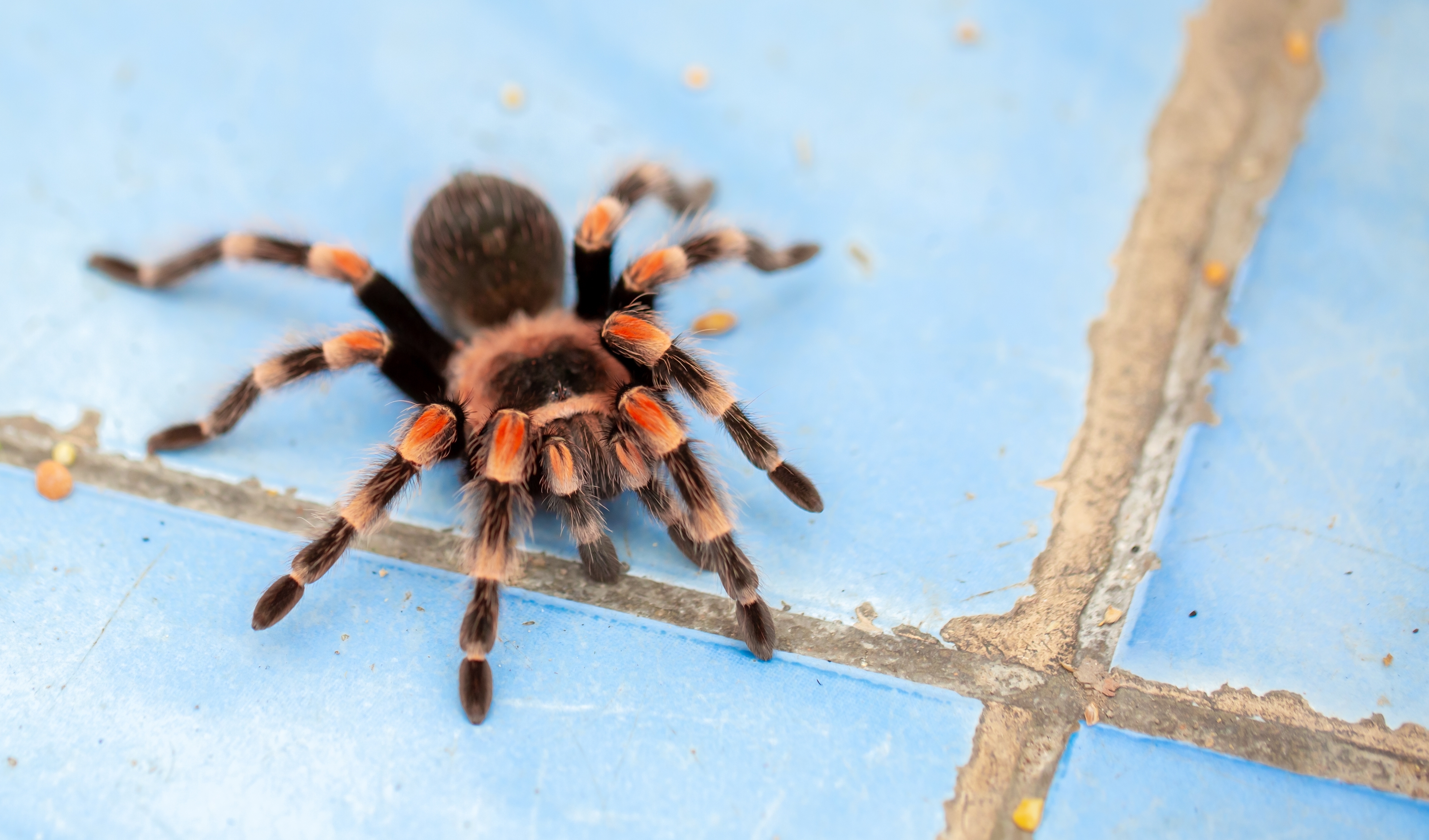Are Tarantulas Poisonous? Understanding Their Risks & Effects
Discover the truth about tarantulas and their venom. Learn about the risks, effects, and what to expect if bitten. Read the article for insights.
Are Tarantulas Poisonous? The Nature of Their Toxicity Toward Humans Remains a Subject for Factual Assessment
Do tarantulas contain venom? Venomous tarantulas pose no serious threat to human safety, although their venom causes pain similar to bee stings. Bites from these spiders normally produce light symptoms in people. It is important to note that tarantulas are not poisonous but are venomous, meaning they inject venom through a bite rather than causing harm if ingested or touched. This article provides details about tarantula venom, its effects on humans, and appropriate responses when experiencing a bite.
- The venomous nature of tarantulas presents minimal danger to humans because their bite resembles bee stinging pain, while serious complications remain exceptionally rare.
- Old World tarantulas produce stronger venom alongside aggressive behavior, but New World tarantulas remain safer for human contact because they deliver less toxic venom.
- When a tarantula bites you, wash the affected area with water while applying ice before getting medical help for severe allergic reactions or severe symptoms.
Understanding Tarantula Venom
The venomous nature of tarantulas remains a matter of concern for people who encounter these animals. Animals that use their mouth to administer toxins through bites or stings fall into the venomous category, while poisonous refers to substances that cause harm through ingestion. Tarantulas possess venom-producing glands that enable them to deliver venom during biting attacks. All tarantulas are venomous and use their venom primarily to hunt prey, not to harm humans.
Tarantulas typically seek safety through retreat rather than active confrontation. They reserve biting behavior for situations when they feel threatened. People who interact with these spiders must understand their defensive behavior to protect themselves from unwanted contact.
How Dangerous Are Tarantula Bites?
A tarantula bite causes pain similar to a bee sting, which may require emergency room visits for proper treatment. The pain from tarantula bites is severe, but such bites rarely lead to serious consequences.
Tarantula bites may result in allergic reactions producing severe symptoms, but such occurrences are extremely rare. A tarantula spider bite does not usually cause serious complications and remains a low-risk situation.
Compared to other spiders, such as the brown recluse or black widow, tarantulas are generally less dangerous to humans.
Old World vs. New World Tarantulas
Tarantulas from Africa and Asia, classified as Old World tarantulas, demonstrate more aggressive tendencies alongside stronger venom than New World species. These tarantulas display defensive behavior with venom that makes handling riskier.
New World tarantulas, native to the Americas, have lower venom potency and display less aggression toward humans. These species are often preferred for handling due to their mild venom and calm nature, making them suitable for beginners who want to keep them as pets. The differences between these tarantula species reduce the potential risks when they bite humans.
Common Symptoms of a Tarantula Bite
A person bitten by a tarantula can expect to experience pain at the bite site, together with redness and swelling. The area surrounding the bite will likely feel warm and become inflamed, but it remains harmless to the person.
Systemic symptoms from tarantula bites may include rapid heart rate and skin rash when allergic reactions occur. It is important to carefully observe the bite area and watch for any unusual health signs.
The cobalt blue tarantula delivers one of the most painful bites among all tarantulas, often leading to severe inflammation. The effects usually disappear within a short period without causing long-term harm. Knowledge of distinct symptoms linked to different tarantula species is important for proper identification.
Are Tarantulas Deadly?
There is no recorded instance of a human death caused by a tarantula bite. According to the American Association of Poison Control Centers, there have been no reported human deaths from tarantula bites. The general population faces no danger from tarantula bites because their venom is only mildly toxic.
While tarantula bites can deliver severe pain exceeding typical levels, they pose no threat to survival. This knowledge helps dispel the fear associated with tarantula venom despite their fearsome appearance.
The cobalt blue tarantula, known for its bright coloration and potent venom, remains harmless to humans. Tarantula venom poses no danger to Americans, providing reassurance to those who encounter these spiders. Understanding tarantula facts helps overcome misconceptions about their bites.
Urticating Hairs: A Unique Defense Mechanism
New World tarantulas have developed urticating hairs as a special defense system. When threatened, they launch numerous tiny hairs toward potential danger using their back legs. These hairs can irritate the respiratory tract if inhaled and create severe skin irritation upon contact with human skin or mucous membranes.
Protective eyewear, latex gloves, and long sleeves help prevent contact with urticating hairs when handling New World tarantula species, reducing uncomfortable skin reactions.
Most Venomous Tarantula Species
The cobalt blue tarantula (Cyriopagopus lividus) is one of the venomous species in the tarantula family. Native to Myanmar and Thailand, it is notable for its striking blue coloration on its legs.
A bite from this tarantula leads to painful swelling, yet medical reports show no deadly outcomes. While the Brazilian Wandering Spider and Sydney Funnel Web Spider are known for their potent venom and greater danger to humans, tarantulas are not considered deadly.
Tarantulas found in the United States and South America have venom not considered dangerous to humans but can cause allergic reactions in some individuals.
What to Do If Bitten by a Tarantula
If bitten by a tarantula, clean the affected area with soap and water to prevent infection. To reduce swelling and pain, apply ice wrapped in a clean cloth to the bite site for 10 minutes, then remove it for 10 minutes, repeating as needed.
If tarantula hairs are present on the skin, gently remove them using sticky tape before washing the area.
Contact your local poison control center for additional guidance on how to proceed.
Seek immediate medical assistance if you experience intense pain, swelling of the lips or throat, or any signs of an allergic reaction. In rare cases, symptoms such as muscle spasms may occur, requiring urgent medical attention.
When contacting emergency services, provide the patient’s age, information about the spider species, and the time of the bite to help medical staff deliver optimal care.
Preventing Tarantula Bites
Avoid touching tarantulas unless you have expertise in reading their body signals to prevent accidental bites. Tarantulas exhibit unpredictable behavior and become defensive when sensing threats.
Pet tarantulas are generally not suitable for handling, and bites can occur if they feel threatened or stressed.
Tarantulas do not develop tamer behavior and will only accept limited handling. Increased handling stresses them, leading to defensive biting.
When threatened, tarantulas may display attack behavior by raising their front legs and showing their large fangs as a warning.
Tarantula Characteristics
Tarantulas are among the largest and most recognizable hairy spiders in the world, belonging to the family Theraphosidae. These spiders are found across a wide range of regions, including the Americas, Africa, Asia, and parts of Europe. With over 850 known species, tarantulas display remarkable diversity in size, color, and behavior.
Despite their intimidating appearance, tarantulas are generally harmless to humans and play a vital role in their ecosystems by controlling insect populations and other small animals. Many people are fascinated by tarantulas, and some species have become popular pets due to their unique characteristics and relatively simple care requirements. As members of the spider family, tarantulas contribute to the balance of nature and are valued both in the wild and in captivity.
Tarantula Habitat and Behavior
Tarantulas thrive in a variety of habitats, from dense forests and open grasslands to arid deserts. These spiders are expert burrowers, often creating underground tunnels or dens where they spend much of their time. Tarantulas are nocturnal creatures, preferring to hunt and explore under the cover of darkness. During the day, they remain hidden in their burrows or beneath rocks and logs to avoid predators.
As skilled hunters, tarantulas use their venomous fangs to subdue prey such as insects, small frogs, and even the occasional snake. One of their most distinctive defense mechanisms is the release of urticating hairs from their abdomen, which can cause irritation to potential threats. This combination of venom and irritating hairs helps tarantulas protect themselves and secure their place as effective predators in their environment.
Understanding Tarantula Bites
Tarantula bites are uncommon and typically occur only when a tarantula feels threatened or is handled improperly. Most tarantulas are not aggressive toward humans and will only bite as a last resort in self-defense. When a tarantula bite does happen, the effects are usually limited to localized pain, swelling, and redness at the bite site. However, some individuals may experience an allergic reaction, which can lead to more serious symptoms.
It is important to remember that tarantulas do not seek out humans to bite, and the vast majority of interactions are harmless. If bitten by a tarantula, prompt medical attention is recommended, especially if severe symptoms or known allergies are present. Understanding tarantula behavior and respecting their space greatly reduces the risk of being bitten.
Tarantula Venom Composition
Tarantula venom is a sophisticated blend of proteins, peptides, and other bioactive molecules. This venom is primarily designed to immobilize prey and provide defense against predators. The specific composition of tarantula venom varies between species, but it generally includes neurotoxins and hemotoxins that can cause pain and inflammation.
For humans, the effects of tarantula venom are usually mild and comparable to the discomfort of a bee sting. While the venom is potent enough to subdue insects and small animals, it is not considered dangerous to people. The complexity of tarantula venom reflects the spider’s evolutionary adaptation to its environment and its role as an effective predator.
The Effects of a Tarantula Bite
The impact of a tarantula bite on humans depends on several factors, including the species of tarantula, the amount of venom injected, and the individual’s sensitivity. Most tarantula bites result in localized pain, swelling, and redness at the bite site, which typically resolve within a few hours to a few days. In some cases, people may experience additional symptoms such as muscle cramps, nausea, or vomiting.
Rarely, a tarantula bite can provoke a severe allergic reaction, which may require immediate medical intervention. Despite these possibilities, tarantula bites are infrequent, and most tarantulas are not aggressive toward humans. By understanding the risks and knowing how to respond if bitten by a tarantula, people can safely appreciate these fascinating spiders without undue concern.
Frequently Asked Questions
Are tarantulas poisonous?
Tarantulas possess venom that causes localized pain at the bite area but are not poisonous. They inject venom through bites rather than causing harm through ingestion or touch.
Are tarantula bites dangerous to humans?
Tarantula bites cause minor to moderate pain, similar to bee stings. Serious health issues are very rare.
What should I do if bitten by a tarantula?
Wash the affected area with soap and water, apply ice to reduce swelling, and contact your local poison control center for guidance.
When should I seek emergency medical assistance after a tarantula bite?
Seek immediate help if you experience severe pain, swelling of lips or throat, muscle spasms, or any signs of an allergic reaction.
How can I protect myself from tarantula bites?
Avoid handling tarantulas unless experienced, understand their behavior, and wear protective clothing when necessary.
Do tarantulas eat insects?
Yes, insects are their primary prey. They use stealth and venomous bites to subdue and consume them.
Where do tarantulas live?
Tarantulas inhabit diverse environments including deserts, grasslands, and rainforests across the Americas, Africa, Asia, and parts of Europe.
What is tarantula spider toxicity?
It refers to the effects of their venom. While generally mild, some species have more potent venom that can cause severe symptoms in rare allergic cases.



